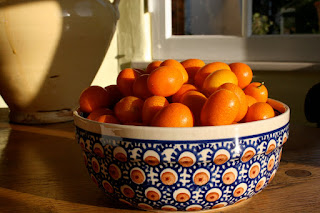Last weekend I went to LA to celebrate my grandparents 60th wedding anniversary! While I was down south my mother introduced me to an amazing woman by the name of Leah. Leah has helped my mom, who has been a Kindergarten teacher in Culver City Unified School District for 25 years, start composting all the food scraps generated on the Kindergarten yard. Now Leah and a "green team" of parents are working to bring composting and recycling to the whole school. As you can imagine, this woman is my new hero.
In addition to being a recycling angel, Leah is also a gardener and urban scavenger. After a brief conversation with her, it was clear that she knew where all the good, under-harvested fruit trees in her neighborhood were... not only is she is a recycler, she's a waste source reducer by not letting delicious fruit go to waste!
As a gift, Leah picked a neighbor's kumquat tree and brought over the bounty. Sour and sweet, I miss the delicious flavor of kumquats... no local citrus in Seattle.
Knowing that I would not be able to eat that many kumquats in a single day, I decided to preserve the harvest by making marmalade.
Kumquat Marmalade:
4 cups of kumquats sliced like pennies, seeds reserved
3 cups sugar (more or less depending on the sweetness of your fruit)
4 cups water
1. Enclose the seeds in cheese cloth.
2. In a large, non-reactive pot add the kumquat slices, seeds, and water.
3. Bring to boil.
4. Once water has started to boil add sugar, reduce heat, and simmer for 2 hours.
5. Cover pot with a lid and let sit over night or at least 5 hours.
6. The next day remove the seeds and return the mixture to a boil.
7. Allow the mixture to simmer for approximately two hours, or until it reaches the right consistency.
I test consistency by adding a teaspoon to a freezer-chilled plate. If it gells you are done.
8. At this point you have marmalade that is either ready to be popped in the fridge or canned.
If the marmalade is too thick (it becomes hard), it is easy to fix by simply adding more water.







